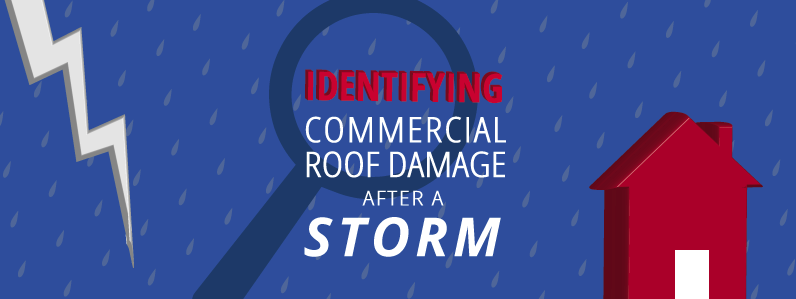

Initial Damage Assessment
After the storm has passed, perform an initial damage assessment as soon as it is safe to do so.
Check for fallen limbs and other debris, such as fallen branches and leaves, which both puncture the roof cover and hold in moisture, leading to water damage. Likewise, after a hailstorm, check for dents or dimples in the roof which can tear into the roof membrane if left unrepaired.
Beyond visible damage and punctures, be on the lookout for any water stains and bubbling, as these can be indicators of severe damage, as well as for any shingles or pieces of equipment that have been bent or knocked loose by high winds.
You’ll want to look for any prominent leaks or visible problems when making your initial evaluation. Once you have evaluated all of the damage and understand the scope of repairs that will need to be made, it’s time to start creating a strategy to fix it.
Prioritizing
After performing your initial damage assessment, you should have an idea of what steps will need to be taken to repair your roof and get it back in working order. But where do you begin?
It’s important to establish priorities when evaluating the damage to your roof. Any part of your roof that is leaking is top priority to attend to, as are any holes or punctures that could become leaks in the future. Leave minor scrapes and non-moisture problems until after the biggest issues are resolved.
One essential area to check is the metal flashing located at the joints of the roof. Even the slightest holes or loose pieces can present entryways for rainwater or other contaminants, so these areas should be some of the first you check during the initial damage assessment and should be some of the first sections that get repaired.
Thorough Inspections
It’s imperative to check every part of your roof after a storm, even those that aren’t outwardly visible.
For example, areas that can often be overlooked after a storm are penetrations and penetration flashings, which should be checked to be sure they are firmly attached to the roof. Similarly, you should make sure that any equipment screens are still resilient enough to survive future storms.
You’ll also want to look and see if your gutters and roof drains are clogged. In order to be sure that nothing has been dislodged from your roof, you’ll want to pay particular attention to the intersections of walls if your roof has multiple levels or floors.
Once it’s safe, walk around on your roof and listen for crunching sounds, this could be an indicator that the roof was lifted during the storm and is settling back into place when you walk over it. If the storm was severe enough, water could have breached into the substrate, you can complete a non-destructive moisture survey to better understand the damage.
It’s important to promptly address water in the substrate as it can lead to mold and other problems in the future. If this is the case, the leak should be properly repaired and the damaged insulation should be replaced as well.
Hail can damage roofs in non obvious ways too, for example, hail can weaken the felt on your roof so it’s not water resistant, even though it appears in tact.
Moisture Penetration
The two ways for identifying moisture in a roof are a nuclear moisture scan or an infrared examination. The next step in this process is to bring in a roofing consultant. If you’re at all unsure about the state of your roof, it’s beneficial to bring in an expert.
This is important because a roofing consultant will be able to determine whether action needs to be taken toward repairing the roof. The roofing consultant can do forensic testing in order to rule out any unseen damage.
If the damage to your roof is extensive, you’ll want to get in touch with your insurance company to see if it makes sense to replace the roof. If you need to repair more than 25-30 percent of your roof, it could make sense to replace the whole roof.
Lastly, it’s important to make sure that your roof is in good shape for the next storm to hit. It’s imperative to take any necessary measures in repairing your roof so it is durable for the next storm and can prevent more serious problems in the future.
At Bone Dry, our team of licensed and certified professionals know every step of the commercial roofing process. If you’re looking for a roof built to last, contact us, request a consultation, and we’ll show you what a roof that stays leak-free and bone-dry for years to come looks like.
